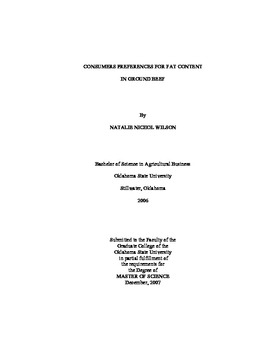| dc.contributor.author | Wilson, Natalie Nichol | |
| dc.date.accessioned | 2014-04-15T19:53:00Z | |
| dc.date.available | 2014-04-15T19:53:00Z | |
| dc.date.issued | 2007-12-01 | |
| dc.identifier.uri | https://hdl.handle.net/11244/8738 | |
| dc.description.abstract | Beef is considered less healthy than its two closest competitors: pork and poultry. This has led to research to determine ways to improve healthiness by altering the type and content of fat in beef products. There remains a great deal of uncertainty about the value consumers place on these nutritional improvements, which has slowed the development and marketing of such products. A survey was developed to determine consumers preferences for fat content in ground beef and to identify how consumers would most like the healthiness of fat content to be improved. The survey was mailed to a random sample of 2,000 individuals throughout the United States. Survey responses to choice-experiment question were used to define consumers utility for ground beef as a function of five ground beef attributes: percent lean, omega 6 to omega 3 fatty acid ratio, percent saturated fat, percent conjugated linoleic acid, and product price. Responses to a series of best-worst questions were used to identify which methods consumers most preferred to improve fat content: cattle fed a diet primarily consisting of grass or green leafy hay, supplement with fish meal, supplement with flaxseed oil, use genetic testing to breed only cattle with improved fatty acid content, sort existing cattle and label those with improved fatty acid content or clone cattle with improved fatty acid content. A second series of best-worst questions were used to identify which attributes of ground beef are most important to consumers when making purchase decisions: expiration date, price, food safety, total amount of fat, package size and fatty acid composition. Findings and Conclusions: Results reveal that consumers are willing to pay for beef with lower amounts of saturated fat and lower omega 6:3 ratios. Feeding a diet high in grass is the most preferred method to improve the fat content while the least desirable is cloning cattle. Finally, the most important attribute to consumers when purchasing ground beef is food safety while package size is the least important. | |
| dc.format | application/pdf | |
| dc.language | en_US | |
| dc.publisher | Oklahoma State University | |
| dc.rights | Copyright is held by the author who has granted the Oklahoma State University Library the non-exclusive right to share this material in its institutional repository. Contact Digital Library Services at lib-dls@okstate.edu or 405-744-9161 for the permission policy on the use, reproduction or distribution of this material. | |
| dc.title | Consumers Preferences for Fat Content in Ground Beef | |
| dc.type | text | |
| osu.filename | Wilson_okstate_0664M_2527.pdf | |
| osu.college | Agricultural Sciences and Natural Resources | |
| osu.accesstype | Open Access | |
| dc.description.department | Department of Agricultural Economics | |
| dc.type.genre | Thesis | |
